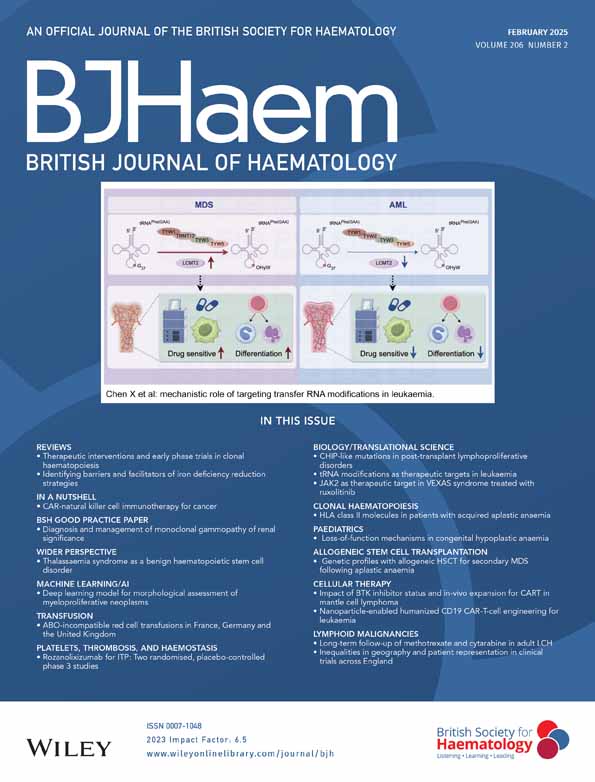Dissecting the genomic traits and clinical course of secondary myelodysplastic syndrome following aplastic anaemia: A milestone
Abstract
Dissecting the genomic traits and clinical course of secondary myelodysplastic syndrome following aplastic anaemia is a milestone. The report by Li and colleagues investigates determinants of evolution to myelodysplastic syndrome and acute myeloid leukaemia in patients with aplastic anaemia and paroxysmal nocturnal haemoglobinuria with a specific focus on post-transplant outcomes.
Commentary on: Li et al. Clinical and genetic profiles and outcomes of allogeneic haematopoietic stem cell transplantation in secondary myelodysplastic syndrome following aplastic anaemia. Br J Haematol 2025; 206:753-757.
In their paper, Li et al.1 embarked in the understanding of the determinants of evolution to myelodysplastic syndrome (MDS) and acute myeloid leukaemia (AML) in patients with aplastic anaemia (AA) and paroxysmal nocturnal haemoglobinuria. The authors specifically focused on patients undergoing allogeneic haematopoietic cell transplant (allo-HCT) to study outcomes and differences with patients with AA receiving transplant upfront before progressing to MDS/secondary AML (sAML). To find genetic and clinical factors pointing towards possible biomarkers, the authors utilized a monocentric cohort of 677 cases, of which 25 were secondary MDS (sMDS) post-AA who underwent allo-HCT, 377 de novo MDS and 285 AA without clonal progression. In total, 80% of sMDS patients evolved from non-severe AA (NSAA) and the overall response rate before MDS evolution was 52%.
While this study represents a valuable contribution to the clinical practice of patients with AA in general, numerous studies2-10 (either reported on single cohort of AA or comparisons between AA and de novo MDS) have dissected the genomic background and clinical course of sMDS post-AA. However, many questions remain still unanswered.
In the present study, the diagnostic differences identified between sMDS post-AA and de novo MDS patients were lower blast percentage and incidence of bone marrow fibrosis at diagnosis, consistent with an early MDS status before allo-HCT in sMDS post-AA. Genomic screening identified increased frequencies of GATA2 and PIGA in sMDS post-AA versus U2AF1 in de novo MDS and monosomy 7 or del(7q) (mostly isolated) in sMDS post-AA versus de novo MDS (32% vs. 12%) affecting post-transplant relapse but not overall survival. Chromosome 7 abnormalities seemed also impacting much more the post-transplant prognosis of de novo MDS versus those evolving post-AA. It is noteworthy here that, beyond disease-specific characteristics, performance status and transplant-related factors (e.g. type of donor, graft versus host diseases (GvHD) prophylaxis, conditioning regimen) are important determinants of a patient's journey after allo-HCT.
Notably, sMDS post-AA, de novo MDS and AA had similar engraftment rates, infection complications and GvHD disease incidence. Given the inclusion of early diagnosed MDS and a higher number of NSAA and the exclusion of therapy-related MDS, the current analysis showed better post-transplant status for sMDS compared to previous studies.11, 12
Although the study marginally defines some distinctions between groups, still leaves the open question on the actual drivers of survival differences between sMDS and de novo MDS after transplant. The crucial question is which are the determinants or factors longitudinally modifiable during clinical trajectories.
The study emphasized gene sequencing performed at the time of MDS diagnosis, which does not exclude low frequency gene mutations at AA disease manifestation. Such analysis will give also more information on the molecular status of the patients with AA who had no response or poor response to immunosuppressive therapy (IST), a clinical factor correlated to MDS/sAML evolution, as well as the timing of progression to a myeloid disorder. An interesting piece of information of the study is the time to AA to MDS progression and the variability across the spectrum of complete remission (before allo-HCT), non-responders or partial remission to IST. Obviously, there are many confounders including age and baseline parameters at diagnosis that might affect the timing, but it is of interest studying clinical and molecular trajectories of these cases from disease onset. Given that clonal haematopoiesis (CH) is an almost universal feature of AA, and detectable mutations often precede myeloid evolution in AA, the availability of a molecular testing at first disease manifestation will also help understanding whether some CH mutations might be harbinger of late clonal complication in patients with AA undergoing standard immunosuppression. It will be of interest to understand whether the unusual DNMT3A (p.E733G), SF3B1 (p.L747W), NPM1 (p.E245Q) mutations detected in sMDS following AA were CH mutations (refer table S8 of Li et al.1) especially in cases in which only one mutation was detected. This is particularly important for the commented study noting the considerable number of targeted genes tested (n = 141 until 2020; n = 267 after 2020 and current) and the flexibility to dissect the data particularly by analysing recorded variant allele frequency.
It is certain for us, authors commenting this study, that the complexity of bone marrow failure disorders, particularly AA, is far from being completely elucidated and still many outstanding questions remain. When comes to statistics and matching scoring systems, the genetic individuality of patients often gets lost. The intersection with many confounder factors, including genetic features present at disease manifestation, fitness of haematopoietic stem cells, strong involvement of immunoediting and treatment plans remains crucial for clinical course assessment.
CONFLICT OF INTEREST STATEMENT
The authors declare no competing interests.




